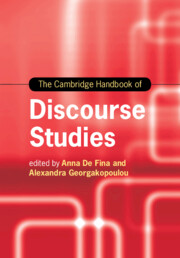Book contents
- The Cambridge Handbook of Discourse Studies
- Cambridge Handbooks in Language and Linguistics
- The Cambridge Handbook of Discourse Studies
- Copyright page
- Contents
- Figures
- Tables
- Contributors
- Preface
- Part I (Con)Textualizing Discourses
- Part II Perspectives and Modes of Analysis
- Part III Discourse Materialities and Embodiment
- Part IV (Trans)Locations and Intersections
- 17 Transnationalism, Globalization and Superdiversity
- 18 Translanguaging and Momentarity in Social Interaction
- 19 Intersectionality, Affect and Discourse
- 20 Expanding Academic Discourses: Diverse Englishes, Modalities and Spatial Repertoires
- Part V Ethics, Inequality and Inclusion
- Part VI Discourses, Publics and Mediatization
- Index
- References
18 - Translanguaging and Momentarity in Social Interaction
from Part IV - (Trans)Locations and Intersections
Published online by Cambridge University Press: 28 September 2020
- The Cambridge Handbook of Discourse Studies
- Cambridge Handbooks in Language and Linguistics
- The Cambridge Handbook of Discourse Studies
- Copyright page
- Contents
- Figures
- Tables
- Contributors
- Preface
- Part I (Con)Textualizing Discourses
- Part II Perspectives and Modes of Analysis
- Part III Discourse Materialities and Embodiment
- Part IV (Trans)Locations and Intersections
- 17 Transnationalism, Globalization and Superdiversity
- 18 Translanguaging and Momentarity in Social Interaction
- 19 Intersectionality, Affect and Discourse
- 20 Expanding Academic Discourses: Diverse Englishes, Modalities and Spatial Repertoires
- Part V Ethics, Inequality and Inclusion
- Part VI Discourses, Publics and Mediatization
- Index
- References
Summary
Social interaction in the twenty-first century involves dynamic use of multilingual and multimodal semiotic resources and is often characterized by the transient, momentary occurrence of creative features. This chapter aims to present Translanguaging as an analytical framework for such dynamic use and creative features in social interaction. The chapter begins with an outline of the diverse phenomena of dynamic and creative practices involving multiple languages and multimodal semiotic resources. Special attention is paid to new media mediated interaction. The characteristics of such practices are identified and discussed. And theoretical issues such as temporality and momentarity are addressed. The chapter then reviews the various analytic concepts, frameworks and approaches that may help to understand these practices, their characteristics and the theoretical issues herein. It focuses specifically on those that have the capacity to offer new insights into the dynamics at the interface of the temporal and spatial dimensions of human social interaction and the creativity of multilingual language users. Perspectives from social semiotics and multimodality, as well as the traditional sociolinguistic and discourse analytic approaches are included. Thus, concepts such as creativity and criticality are also critiqued. The theoretical motivations for the translanguaging perspective and the methodological implications of adopting such a perspective are then discussed and highlighted. It aims to show the added value of translanguaging as an analytic framework for social interaction in the linguistically and culturally diverse world today.
Keywords
- Type
- Chapter
- Information
- The Cambridge Handbook of Discourse Studies , pp. 394 - 416Publisher: Cambridge University PressPrint publication year: 2020
References
- 10
- Cited by



